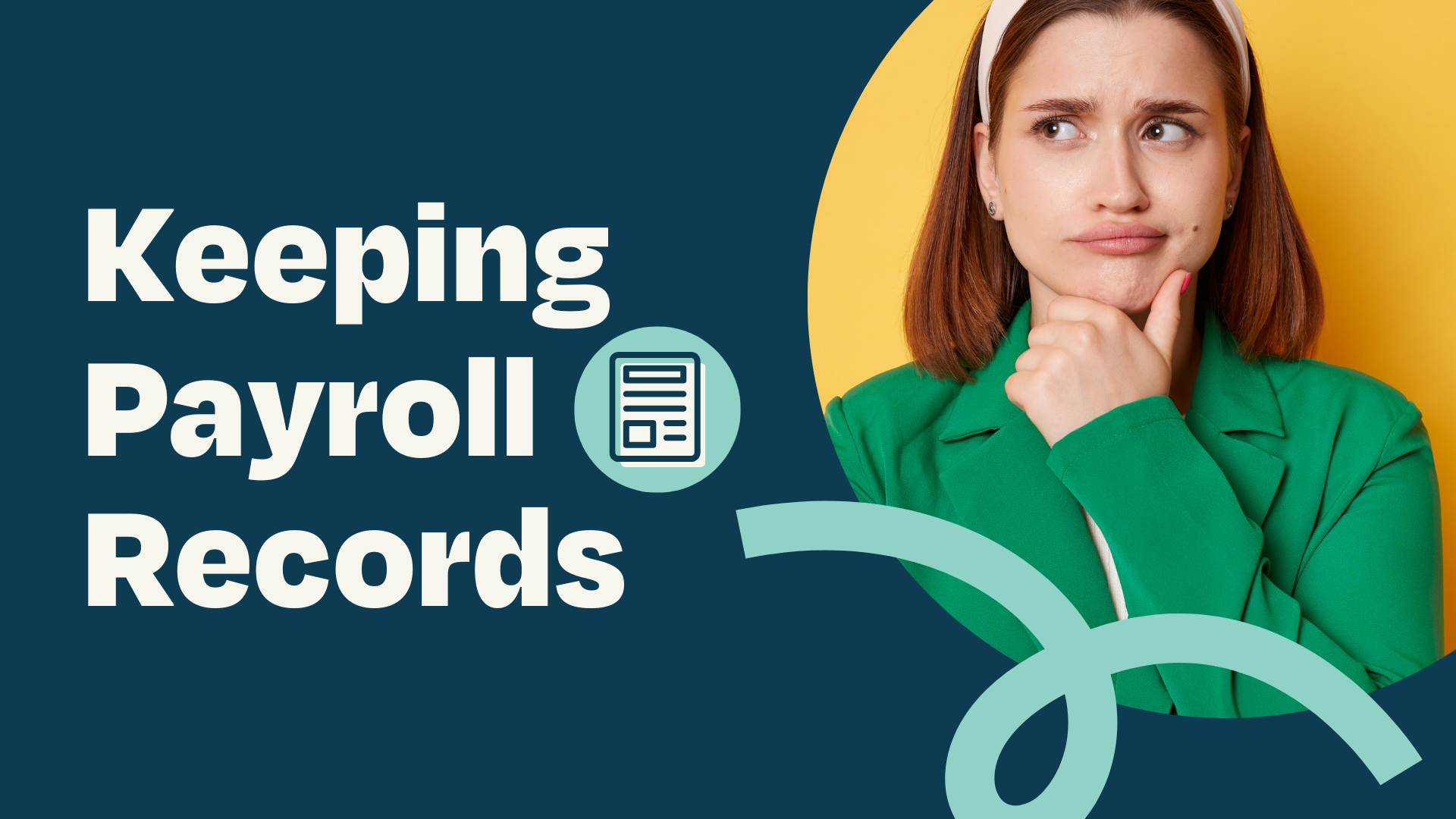Calculating Payroll Costs for Your Employees
Navigating the waters of payroll costs is more than just a routine task for businesses; it's a pivotal element in the grand scheme of financial...
11 min read
Enzo O'Hara Garza
:
November 24, 2023

The task of maintaining payroll records might seem like a mundane detail, yet it stands as a cornerstone of sound financial and legal practice. For small and medium-sized business owners, HR professionals, and payroll managers, understanding how long to keep these records is not just a matter of organizational efficiency; it's a safeguard against potential legal complications and a foundation for transparent business operations.
In this comprehensive guide, we will navigate the often-overlooked yet crucial realm of payroll record retention. We’ll define what constitutes payroll records, unravel the legal requirements for their retention, and explore the best practices for storing, managing, and eventually purging these documents. Whether you’re a seasoned business owner or new to the realm of HR and payroll management, this article is designed to equip you with actionable insights into managing your payroll documentation efficiently and maintaining compliance with confidence.
At the heart of every business's HR and payroll department lies a crucial element: payroll records. But what exactly are these documents, and why are they so important? Payroll records encompass a broad range of documentation related to employee compensation. This includes not just the obvious items like salary or wage details, but also encompasses time sheets, tax forms, benefit information, direct deposit forms, and more. Essentially, any document that pertains to how an employee is paid, the hours they work, and the benefits they receive, falls under the umbrella of payroll records.
These records serve several critical functions in business operations. They are the definitive source of truth for employee compensation, providing clear, historical data that can be referenced in the event of disputes or audits. Moreover, they are not just a matter of internal record-keeping; they are also subject to various legal requirements. Businesses are legally obligated to maintain accurate payroll records for a specified period, primarily for tax and labor law compliance purposes.
The retention of HR and payroll records extends far beyond mere organizational practice; it is a vital aspect of running a business that adheres to legal standards and prepares for unforeseen circumstances. Here's why maintaining these records is absolutely essential:
Legal Compliance: Numerous federal and state laws and regulations require businesses to retain specific employee records for designated periods. For instance, the Fair Labor Standards Act (FLSA) and the Internal Revenue Service (IRS) have distinct requirements for payroll record retention. Failure to comply can result in penalties, legal disputes, and other complications.
Audit Preparedness: Payroll records are frequently requested during audits. These audits can be internal, aimed at ensuring smooth business processes, or external, conducted by government agencies to verify compliance with tax and employment laws. Having comprehensive payroll records readily accessible simplifies the audit process and validates the business's practices.
Dispute Resolution: Disputes concerning wages, overtime, benefits, or other compensation matters may arise, and detailed payroll records often serve as the linchpin for resolving these issues. They provide a historical account of employee compensation and are indispensable in legal proceedings or negotiations.
Business Analysis and Decision Making: Payroll records offer valuable data for business analysis. Insights derived from these records can inform strategic decisions regarding staffing, budgeting, and compensation strategies. They aid in understanding labor costs, identifying trends, and making well-informed business choices.
Employee Relations: Maintaining accurate and comprehensive payroll records contributes to transparent and trustworthy employee relations. Employees may require access to their payroll records for personal reasons, such as loan applications or personal income tax filings. The ready availability of these records can enhance employee trust and satisfaction.
When it comes to storing payroll records, ensuring the security of sensitive employee information is of utmost importance. There are two main approaches you can take to achieve this: physical storage in a secure location or digital storage with encryption and access controls.
If you opt for physical storage, it is crucial to choose a secure location that provides protection against theft, fire, and other potential hazards. This could include a locked filing cabinet or a designated safe within your office premises. Additionally, consider implementing strict access controls to limit the number of individuals who have physical access to these records. This can help prevent unauthorized individuals from gaining access to sensitive information.
Digital storage offers its own set of advantages. By utilizing encryption, you can protect the confidentiality of payroll records by converting the data into a form that can only be accessed with the correct decryption key. This ensures that even if unauthorized individuals gain access to the stored data, they will be unable to decipher it without the encryption key. Implementing access controls for digital storage is equally important. This involves assigning unique login credentials to authorized personnel and regularly updating passwords to maintain the integrity of the system.
Whether you choose physical or digital storage, it is essential to regularly backup your payroll records. This practice mitigates the risk of data loss due to unforeseen circumstances such as hardware failures, natural disasters, or cyberattacks. By maintaining multiple copies of your records, you can easily restore them in the event of an incident and ensure business continuity.
Lastly, it is crucial to establish a record retention policy that outlines the duration for which payroll records should be stored. This policy should align with legal requirements and industry best practices.
When setting up a payroll record system, it is crucial to prioritize the security of sensitive employee information. Lax security measures, such as weak passwords or lack of encryption, can leave your company vulnerable to data breaches and unauthorized access. Implementing strong security measures, such as multi-factor authentication and regular security audits, can help protect your payroll records and minimize the risk of data breaches.
Disorganization is another pitfall to avoid when setting up a payroll record system. Without a well-structured and organized system, it can be challenging to locate and retrieve specific payroll records when needed. This can lead to delays in resolving disputes or responding to audit requests. To prevent disorganization, establish a clear and consistent filing system for your payroll records, whether physical or digital. Use standardized naming conventions and folder structures to ensure easy navigation and retrieval of records.
Inadequate backup systems also pose a significant risk to your payroll records. Without proper backups, you may lose critical employee compensation data in the event of hardware failure, natural disasters, or cyberattacks. Implementing regular backup procedures, both onsite and offsite, can safeguard your payroll records and ensure business continuity. Consider utilizing cloud-based backup solutions for added security and accessibility.
Keeping payroll records is important for several reasons:
Legal compliance: Employers are required by law to keep certain types of records for a specified period.
Dispute resolution: Payroll records can help resolve disputes about pay or hours worked.
Audit preparedness: If your company is audited, you'll need to provide payroll records.
Employee verification: Payroll records can be used to verify employment and compensation for purposes such as loan applications or unemployment claims.
According to the Internal Revenue Service (IRS), it is mandatory for employers to retain payroll tax records for a minimum of four years after the tax is due or paid, whichever comes later. This informative chart provides an overview of the federal requirements for recordkeeping and retention, serving as a useful guide for employers and federal contractors. It outlines the specific duration for which records must be maintained in accordance with federal law.
Type of Records |
Description of Records |
Duration |
||
Affirmative Action RecordsThese requirements only apply to federal supply and service |
Federal contractors and subcontractors must maintain personnel records, including job ads, applications, hiring records, pay rates, training selection, accommodation requests, physical exam results, and affirmative action documentation. Contractors must identify the gender, race, and ethnicity of each employee and applicant where possible. |
Two years from when the personnel record or personnel action occurred, whichever is later. |
||
Apprentice Programs |
Apprenticeship committees that control apprenticeship programs must retain all apprenticeship records, including, but not limited to, a chronological list of names and addresses of all applicants, requests for reasonable accommodation, test papers completed by applicants, and records of interviews. |
Two years from the date the record was made. |
||
Benefits Records |
Data: All data used to support summary plan descriptions and other records supporting plans or reports, including vouchers, worksheets, receipts, and applicable resolutions. |
Generally six years from filing (or date the record would have been filed but for exemption or simplified reporting requirement). |
||
Business Records |
Records showing total dollar volume of sales |
Three years. |
||
Drug and Alcohol Testing Records |
Employers covered under the Department of Transportation’s drug and alcohol testing regulations must maintain records pertaining to test results, testing process administration, return-to-duty process administration, employee training, and supervisor training. |
Employers may need to retain records from one to five years depending on the industry and type of record. The Federal Motor Carrier Safety Administration requires education and training records be retained indefinitely and two years after ceasing to perform functions. |
||
Emergency Paid Sick Leave Act (EPSLA) and Emergency Family and Medical Leave Expansion Act (EFMLEA) Under the FFCRA |
Documentation required to take leave: |
Four years regardless of whether leave was granted or denied. If employee provides oral statements to support the request for EPLSA or EFMLEA, the employer is required to document and maintain such information |
||
EPSLA and EFMLEA Tax Credits |
In order to qualify for tax credits, employers must furnish the following documentation: • Comprehensive records demonstrating how the employer determined the amount of paid sick leave and expanded family and medical leave paid to eligible employees, including detailed records of their work, telework, and the benefits provided under EPSLA or EFMLEA. • Documentation outlining how the employer determined the portion of qualified health plan expenses allocated to wages. • Copies of all completed IRS Forms 7200 that have been submitted to the IRS. • Copies of completed IRS Forms 941 that have been submitted to the IRS. Alternatively, for employers who use third-party payers to fulfill their employment tax obligations, records of the information provided to the third-party payer regarding the employer's entitlement to the claimed credit on IRS Form 941. • Any other pertinent documents required to support the request for tax credits, as specified in the applicable IRS forms, instructions, and guidelines for claiming a tax credit. |
Four years. |
||
Family and Medical Leave Act (FMLA) Records |
FMLA-covered employers are required to maintain records that align with the requirements of the FLSA. These records include basic payroll and employee data, as well as dates of FMLA leave taken by eligible employees, including the hours taken if leave is less than a full day. Employers must also keep copies of employee notices of leave and eligibility notices, which can be stored in employee personnel files. Additionally, documentation related to employee benefits and employer policies regarding paid and unpaid leave should be maintained. Premium payments for employee benefits should also be recorded, along with any disputes between the employer and eligible employees regarding FMLA leave designation. Any records or documents relating to medical certifications, recertifications, or medical histories of employees and their family members should be kept confidential in separate files from regular personnel files. If applicable, records containing family medical history or genetic information should adhere to the confidentiality requirements of GINA. However, supervisors and managers may be informed about necessary work restrictions or accommodations, and first aid and safety personnel may be informed about employees' medical conditions if emergency treatment is necessary. Finally, relevant information should be provided to government officials investigating FMLA compliance or other relevant laws. |
Three years. |
||
Federal Contractors and Subcontractors, Federal Service Contracts |
For each employee working on a service contract, records showing: |
Three years from completion of the work. |
||
Immigration |
Form I-9, Employment Eligibility Verification |
For the duration of employment. Upon termination, the form must be retained either three years after the date of hire, or one year after the date employment is terminated, whichever is later. |
||
Income Tax Withholding |
Records relating to FICA and FUTA income tax withholdings. |
|||
Minor Employees |
Certificates of age for all minors that include the |
Three years. |
||
Miscellaneous Documents (Agreements, Contracts, Certificates, Benefits) |
Written records relating to employee benefits plans, collective bargaining agreements, seniority and/or merit systems, plans, trusts, individual employment contracts, written FLSA agreements, and certificates authorizing payment at less than minimum wage. |
At least three years; the IRS may require longer (up to seven years). |
||
OSHA Records |
The following OSHA records: |
Present year, plus five preceding calendar years. |
||
Payroll Records |
For each employee, records that contain the following: |
|||
Personnel Records |
Records including: |
Statutory requirement is two years; however, four years is generally recommended. |
||
Polygraph Tests |
Employers investigating an economic loss or injury must maintain a copy of the statement about the specific incident or activity under investigation, the basis for testing that particular employee, and proof of service of the statement to the examinee. |
Three years from the date of exam (or from date the exam is requested if no exam is conducted). |
||
Records of Self-Identifying Veterans and Individuals with Disabilities |
Government contractors must keep a separate file |
Three years. |
||
Records Relating to Charge, Complaint, Enforcement Action, or Compliance Review |
Personnel or employment records relating to aggrieved person and to all other employees holding positions similar to that held by aggrieved person, including application forms and test papers completed by aggrieved person and all other persons applying for same position as aggrieved person. |
Until final disposition of the charge, complaint, |
||
Records Relating
|
Records relating to: |
One year after the record is created or the personnel action described is taken, whichever is later. |
||
Time Cards and Schedules |
Records on which wage computations are based (time cards and piece work tickets, wage rate tables, work and time schedules). |
No less than three years. |
||
Wage Differentials |
Records explaining/supporting any wage differentials (including job descriptions, job evaluations, merit, incentive, and seniority systems, etc.). |
Two years. |
||
Whether you're storing records physically or digitally, security is paramount. Access should be limited to authorized personnel, and digital records should be encrypted.
When it's time to dispose of old payroll records, do so securely. This means shredding physical documents and securely deleting digital ones.
Regularly review and update your payroll records to ensure they are accurate and up to date. This is especially important when there are changes to payroll laws or your company's payroll practices.
Keeping payroll records is a crucial part of running a business. By understanding the legal requirements and best practices, you can manage your payroll documentation efficiently and maintain compliance. Remember, the goal is not just to keep records, but to keep them in a way that protects your business and your employees.

Navigating the waters of payroll costs is more than just a routine task for businesses; it's a pivotal element in the grand scheme of financial...
.png)
Gusto Payroll is a cloud-based payroll solution designed to simplify and streamline the payroll process for businesses. With a focus on automation,...

1 min read
As a small business owner, you wear many hats, juggling various responsibilities to keep your company running smoothly. One of the most important...